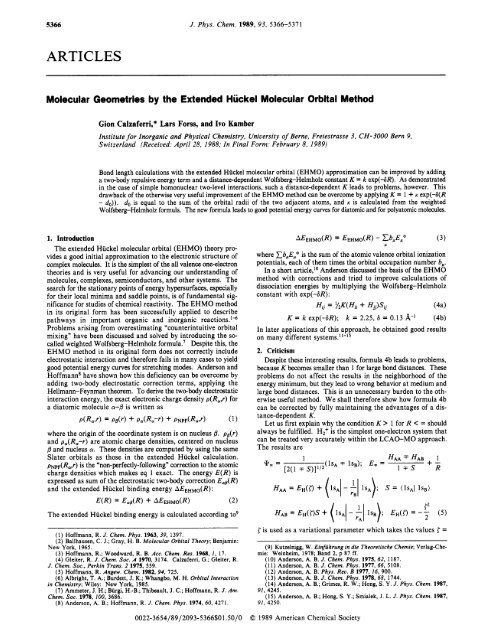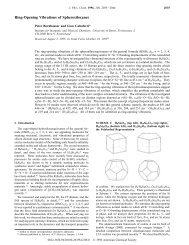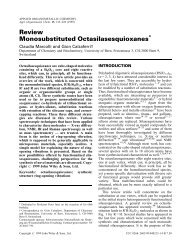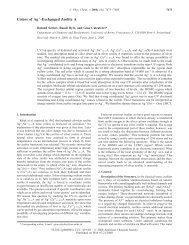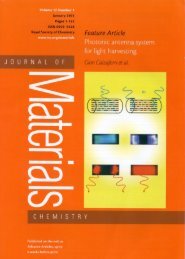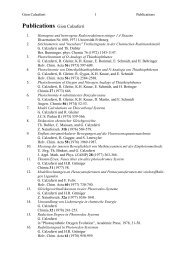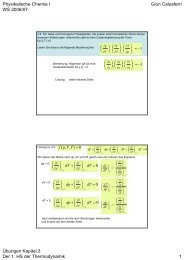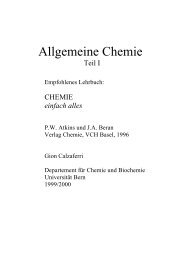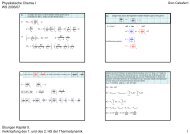Molecular geometries by the Extended Hueckel Molecular Orbital ...
Molecular geometries by the Extended Hueckel Molecular Orbital ...
Molecular geometries by the Extended Hueckel Molecular Orbital ...
You also want an ePaper? Increase the reach of your titles
YUMPU automatically turns print PDFs into web optimized ePapers that Google loves.
5366 J. Phys. Chem. 1989, 93, 5366-5371<br />
ARTICLES<br />
<strong>Molecular</strong> Geometries <strong>by</strong> <strong>the</strong> <strong>Extended</strong> Huckel <strong>Molecular</strong> <strong>Orbital</strong> Method<br />
Gion Calzaferri,* Lars Forss, and Ivo Kamber<br />
Institute for Inorganic and Physical Chemistry, University of Berne, Freiestrasse 3, CH- 3000 Bern 9,<br />
Switzerland (Received: April 28, 1988; In Final Form: February 8, 1989)<br />
Bond length calculations with <strong>the</strong> extended Hiickel molecular orbital (EHMO) approximation can be improved <strong>by</strong> adding<br />
a two-body repulsive energy term and a distance-dependent Wolfsberg-Helmholz constant K = k exp(-GR). As demonstrated<br />
in <strong>the</strong> case of simple homonuclear two-level interactions, such a distance-dependent K leads to problems, however. This<br />
drawback of <strong>the</strong> o<strong>the</strong>rwise very useful improvement of <strong>the</strong> EHMO method can be overcome <strong>by</strong> applying K = 1 + K exp(-G(R<br />
- do)). do is equal to <strong>the</strong> sum of <strong>the</strong> orbital radii of <strong>the</strong> two adjacent atoms, and K is calculated from <strong>the</strong> weighted<br />
Wolfsberg-Helmholz formula. The new formula leads to good potential energy curves for diatomic and for polyatomic molecules.<br />
1. Introduction<br />
The extended Huckel molecular orbital (EHMO) <strong>the</strong>ory pro-<br />
vides a good initial approximation to <strong>the</strong> electronic structure of<br />
complex molecules. It is <strong>the</strong> simplest of <strong>the</strong> all valence one-electron<br />
<strong>the</strong>ories and is very useful for advancing our understanding of<br />
molecules, complexes, semiconductors, and o<strong>the</strong>r systems. The<br />
search for <strong>the</strong> stationary points of energy hypersurfaces, especially<br />
for <strong>the</strong>ir local minima and saddle points, is of fundamental sig-<br />
nificance for studies of chemical reactivity. The EHMO method<br />
in its original form has been successfully applied to describe<br />
pathways in important organic and inorganic reactions.'"<br />
Problems arising from overestimating "counterintuitive orbital<br />
mixing" have been discussed and solved <strong>by</strong> introducing <strong>the</strong> so-<br />
called weighted Wolfsberg-Helmholz formula.' Despite this, <strong>the</strong><br />
EHMO method in its original form does not correctly include<br />
electrostatic interaction and <strong>the</strong>refore fails in many cases to yield<br />
good potential energy curves for stretching modes. Anderson and<br />
Hoffmann6 have shown how this deficiency can be overcome <strong>by</strong><br />
adding two-body electrostatic correction terms, applying <strong>the</strong><br />
Hellmann-Feynman <strong>the</strong>orem. To derive <strong>the</strong> two-body electrostatic<br />
interaction energy, <strong>the</strong> exact electronic charge density p(R,,r) for<br />
a diatomic molecule a-0 is written as<br />
P(RJ) = PB(~) + PAR^-^) + PNPF(RJ) (1)<br />
where <strong>the</strong> origin of <strong>the</strong> coordinate system is on nucleus 0. pB(r)<br />
and p,(R,-r) are atomic charge densities, centered on nucleus<br />
0 and nucleus a. These densities are computed <strong>by</strong> using <strong>the</strong> same<br />
Slater orbitals as those in <strong>the</strong> extended Huckel calculation.<br />
pNPF(Ru,r) is <strong>the</strong> %on-perfectly-following" correction to <strong>the</strong> atomic<br />
charge densities which makes eq 1 exact. The energy E(R) is<br />
expressed as sum of <strong>the</strong> electrostatic two-body correction EUB(R)<br />
and <strong>the</strong> extended Huckel binding energy AEEHMO(R):<br />
E(R) = EaB(R) + AEEHMo(R)<br />
The extended Hiickel binding energy is calculated according to9<br />
(1) Hoffmann, R. J. Chem. Phys. 1963, 39, 1397.<br />
(2) Ballhausen, C. J.; Gray, H. B. <strong>Molecular</strong> <strong>Orbital</strong> Theory; Benjamin:<br />
New York, 1965.<br />
(3) Hoffmann, R.; Woodward, R. B. Acc. Chem. Res. 1968, 1, 17.<br />
(4) Gleiter, R. J. Chem. SOC. A 1970, 3174. Calzaferri, G.; Gleiter, R.<br />
J. Chem. Soc., Perkin Trans. 2 1975, 559.<br />
(5) Hoffmann, R. Angew. Chem. 1982, 94, 725.<br />
(6) Albright, T. A.; Burdett, J. K.; Whangbo, M. H. <strong>Orbital</strong> Interaction<br />
in Chemistry; Wiley: New York, 1985.<br />
(7) Ammeter, J. H.; Blirgi, H.-B.; Thibeault, J. C.; Hoffmann, R. J. Am.<br />
Chem. SOC. 1978, 100, 3686.<br />
(8) Anderson, A. B.; Hoffmann, R. J. Chem. Phys. 1974, 60, 4271.<br />
(2)<br />
AEEHMoW = EEHMo(R) - Cb,E,O (3)<br />
where Cb,E,O is <strong>the</strong> sum of <strong>the</strong> atomic valence orbital ionization<br />
potentials, each of <strong>the</strong>m times <strong>the</strong> orbital occupation number b,.<br />
In a short article,'O Anderson discussed <strong>the</strong> basis of <strong>the</strong> EHMO<br />
method with corrections and tried to improve calculations of<br />
dissociation energies <strong>by</strong> multiplying <strong>the</strong> Wolfsberg-Helmholz<br />
constant with exp(-SR):<br />
Hij = )/2K(H,i + Hjj)Sij<br />
(44<br />
K = k exp(-SR); k = 2.25, 6 = 0.13 A-' (4b)<br />
In later applications of this approach, he obtained good results<br />
on many different system^."-'^<br />
2. Criticism<br />
Despite <strong>the</strong>se interesting results, formula 4b leads to problems,<br />
because K becomes smaller than 1 for large bond distances. These<br />
problems do not affect <strong>the</strong> results in <strong>the</strong> neighborhood of <strong>the</strong><br />
energy minimum, but <strong>the</strong>y lead to wrong behavior at medium and<br />
large bond distances. This is an unnecessary burden to <strong>the</strong> oth-<br />
erwise useful method. We shall <strong>the</strong>refore show how formula 4b<br />
can be corrected <strong>by</strong> fully maintaining <strong>the</strong> advantages of a dis-<br />
tance-dependent K.<br />
Let us first explain why <strong>the</strong> condition K > 1 for R < a should<br />
always be fulfilled. H2+ is <strong>the</strong> simplest one-electron system that<br />
can be treated very accurately within <strong>the</strong> LCAO-MO approach.<br />
The results are<br />
{ is used as a variational parameter which takes <strong>the</strong> values { =<br />
(9) Kutzelnigg, W. Einfuhrung in die Theoretische Chemie; Verlag-Chemie:<br />
Weinheim, 1978; Band 2, p 87 ff.<br />
(10) Anderson, A. B. J. Chem. Phys. 1975, 62, 1187.<br />
(11) Anderson, A. B. J. Chem. Phys. 1977,66, 5108.<br />
(12) Anderson, A. B. Phys. Reu. E 1977, 16, 900.<br />
(13) Anderson, A. B. J. Chem. Phys. 1978, 68, 1744.<br />
(14) Anderson, A. B.; Grimes, R. W.; Hong, S. Y. J. Phys. Chem. 1987,<br />
91, 4245.<br />
(15) Anderson, A. B.; Hong, S. Y.; Smialek, J. L. J. Phys. Chem. 1987,<br />
91, 4250.<br />
0022-3654/89/2093-5366$01.50/0 0 1989 American Chemical Society
<strong>Molecular</strong> Geometries <strong>by</strong> <strong>the</strong> EHMO Method<br />
2 at R = 0, { = 1.228 at R = Ro, and { = 1 at R - a. Bond<br />
length and bond energy calculated with this approach differ <strong>by</strong><br />
less than 1% from <strong>the</strong> experimental values.<br />
Let us examine <strong>the</strong> energy difference between <strong>the</strong> bonding and<br />
<strong>the</strong> antibonding orbital:<br />
2<br />
E+ - E- = - (HAB - HAAS)<br />
1 -s2<br />
Since HAA and HAB are both negative and S is positive, <strong>the</strong><br />
condition HA, < HAAS must hold to avoid crossing of E+ and E-.<br />
In <strong>the</strong> case of H2+ this is fulfilled.<br />
More generally, a two-level interaction X-X with HAB = HBA<br />
can be described as<br />
lHM HAB- ES HAA- E<br />
from which we get<br />
and <strong>the</strong>refore<br />
- e HAB- CS<br />
I = O<br />
HAA + HAB HAA - HAB<br />
E+= l+s ' e-= 1 -s<br />
Dividing AE+ <strong>by</strong> AE- leads to<br />
- AE+ = -- 1 -s
5368 The Journal of Physical Chemistry, Vol. 93, No. 14, 1989 Calzaferri et al.<br />
TABLE I: Comparison of Experimental and Calculated Data of Some<br />
Diatomic and Polyatomic Molecules"<br />
TABLE II: Comparison of Experimentnl and Calculated Data for<br />
Molecules with C-0 Multiple Bonds"<br />
molecule<br />
H2<br />
Liz<br />
4 2<br />
c2<br />
LiH<br />
CuH<br />
A$H<br />
re<br />
0.74<br />
0.80<br />
2.67<br />
2.31<br />
2.48<br />
2.8 1<br />
1.24<br />
1.28<br />
1.60<br />
1.63<br />
1.46<br />
1.38<br />
1.62<br />
1.71<br />
a. Diatomic Molecules<br />
IP, A-X<br />
15.43 l2,,+ - '2.'<br />
15.37<br />
5.0<br />
5.22<br />
7.56<br />
7.82<br />
12.15<br />
12.11<br />
7.7<br />
9.50<br />
11.23<br />
1 1.26<br />
AE<br />
11.37<br />
16.74<br />
1.74<br />
2.88<br />
2.85<br />
1.55<br />
2.17<br />
3.28<br />
3.17<br />
2.91<br />
4.32<br />
3.71<br />
3.42<br />
Doa<br />
4.48<br />
5.52<br />
1.05<br />
2.18<br />
1.66<br />
3.15<br />
6.21<br />
5.83<br />
2.43<br />
2.66<br />
2.7<br />
3.91<br />
2.28<br />
3.74<br />
molecule re IP A- X AE Do"<br />
co 1.13 14.01 c + IZ+ 11.09<br />
1.15 13.18 uld u2 4.75 9.43<br />
Si0 1.51 11.43 c - I2' 8.26<br />
1.55 11.73 a'd + 5' 3.7 8.20<br />
molecule 'C IP HOMO LUMO<br />
eo, 1.16 d 14.01<br />
1.20 d 13.66 r7rB "8""<br />
CHzO 1.21, 1.10 121.1 12.18<br />
1.23, 1.08 119.0 11.88 nb2 **bl<br />
For each molecule, <strong>the</strong> upper and lower numbers represent experimental<br />
and calculated data, respectively. Distances are in angstroms<br />
and energies in electronvolts. 1 + K = 2.00, 6 = 0.35, and 1 + K = 2.25<br />
for SiO. bDo(calcd) = D,(calcd) - 1/2w,. cNot directly comparable<br />
symmetry states. dLinear.<br />
HCI<br />
co<br />
1.27<br />
1.42<br />
1.13<br />
12.75<br />
12.86<br />
14.01<br />
10.98<br />
4.43<br />
4.07<br />
1 1.09<br />
sum of <strong>the</strong> orbital radii r,(A) + r,(B) which are defined <strong>by</strong> <strong>the</strong><br />
following equation:<br />
cs<br />
1.35<br />
1.53<br />
13.35<br />
11.33<br />
2.74 5.10<br />
7.35<br />
1.59 11.11<br />
2.65 5.36<br />
Si0 1.51 1 1.40<br />
8.26<br />
2.20 11.10<br />
0.93 1.38<br />
For Slater-type orbitals this leads to (14a) and in case of double-{<br />
b. Polyatomic Molecules<br />
functions to (1 4b):<br />
molecule r. IP HOMO LUMO<br />
H20 0.96<br />
1.15<br />
105.2<br />
111.5<br />
12.61<br />
12.81 nbl 0*b2<br />
H2S 1.33<br />
1.39<br />
92.2<br />
103.0<br />
10.47<br />
11.46 nb, a*bz<br />
COX 1.16 d 13.77<br />
1.40 d 13.74 7rrg 7r*lru<br />
CH2O 1.21, 1.10 121.1 10.88<br />
1.43, 1.18 124.0 11.88 nb2 a*bl<br />
CH4 1.09<br />
1.15<br />
e<br />
e<br />
12.99<br />
13.74 at2 a*t2<br />
SiH4 1.48 e 12.82<br />
1.58 e 14.10 atz a*t2<br />
" For each molecule, <strong>the</strong> upper and lower numbers represent experimental<br />
and calculated data, respectively. Distances are in angstroms<br />
and energies in electronvolts. 1 + K = 1.75, 6 = 0.13. bDo(calcd) =<br />
DJcalcd) - 1 /2wc. 'Not directly comparable symmetry states.<br />
dLinear. 'Tetrahedral.<br />
<strong>the</strong> series H2 to Ag2. From this data we extrapolate IP[Au2] =<br />
9.18 eV which has not yet been measured, as far as we know. The<br />
experimental values have been taken from ref 19-21.<br />
Equation 11 supports <strong>the</strong> general validity of Scheme I for <strong>the</strong><br />
description of <strong>the</strong> (nsuE,nsuu) levels and of <strong>the</strong> BIZ,+ - XIBE+<br />
transitions of H2 to A u ~ h,, . is ~ <strong>the</strong> ~ atomic ~ ~ valence orbital<br />
ionization potential, and h,' is <strong>the</strong> valence orbital ionization potential<br />
after <strong>the</strong> atoms have approached bond distance.<br />
The aim of this section is to emphasize that <strong>the</strong> above given<br />
interference rule should not be violated in a one-electron scheme<br />
for <strong>the</strong> description of chemical bonds, unless very special conditions<br />
apply as discussed in ref 7. Consequently, K > 1 must be fulfilled<br />
for finite bond distances.<br />
3. Correction<br />
We now give a correction that maintains all <strong>the</strong> advantages of<br />
a distance-dependent K but circumvents <strong>the</strong> mentioned problems<br />
of eq 4b. We propose <strong>the</strong> following equation:<br />
K = 1 + K exp[-G(R - do)] (1 2a)<br />
K and 6 are positive empirical parameters while do is equal to <strong>the</strong><br />
(19) Kappes, M. M.; Schar, M.; Schumacher, E. J. Phys. Chem. 1985.89,<br />
1499.<br />
(20) Morse, M. D. Chem. Rev. 1986, 86, 1049.<br />
(21) CRC Handbook of Chemistry and Physics, 55th ed.; CRC Press:<br />
Bota Raton, FL, 1974.<br />
a, is <strong>the</strong> Bohr radius, and do corresponds approximately to observed<br />
bond distances. This means that in <strong>the</strong> neighborhood of <strong>the</strong><br />
equilibrium bond distance, eq 12a takes <strong>the</strong> simple form<br />
K(R=do) = 1 + K<br />
(12b)<br />
Instead of introducing a new parameter K, this allows to calculate<br />
K <strong>by</strong> means of <strong>the</strong> weighted Wolfsberg-Helmholz formula' at R<br />
= do.<br />
HIJ = '/,Ks,,[Hl, + HJJl<br />
K=(1 +K)+A'-A~K; 1+~=1.75<br />
Hi, - Hjj<br />
A=- (15)<br />
+ H]J<br />
Applying (15), eq 12a can be written as follows:<br />
K = 1 (K + A' - A4~) exp[-G(R - do)] (12C)<br />
6 is positive. As a consequence, K increases with decreasing<br />
interatomic distances, as it should be.<br />
After introducing <strong>the</strong> corrected distance-dependent Wolfsberg-Helmholz<br />
formula, we now briefly discuss <strong>the</strong> electrostatic<br />
two-body interaction EuB(R). In his original paper, Anderson<br />
introduced <strong>the</strong> electrostatic energy to describe <strong>the</strong> interaction<br />
E@(&) of nucleus a with <strong>the</strong> neutral atom ,!3 in a nonsymmetrical<br />
way using <strong>the</strong> electron density of <strong>the</strong> more electronegative atom<br />
only. This deficiency can easily be corrected <strong>by</strong> taking <strong>the</strong> arithmetic<br />
mean:'6~22*23<br />
Equation 16 can be written as follows:<br />
~~ ~~ ~ ~~~<br />
(22) Beran, S.; Slanina, Z.; Zidarov, D. C. Inr. J. Quantum Chem. 1978,<br />
--. 13 -- 221<br />
(23) CarM, R.; Fornos, J. M.; Hemindez, J. A.; Sanz, F. Int. J. Quantum<br />
Chem. 1977, 11, 21 1.
<strong>Molecular</strong> Geometries <strong>by</strong> <strong>the</strong> EHMO Method<br />
1 101 ,<br />
'",',,,<br />
I<br />
I H2<br />
0.3 0.5 0.7 0.9 1.1 1.3<br />
r (H-H) t A 1<br />
-5 r<br />
1.0 1.2 1.4 1.6 1.8 2.0 2.2 2.4<br />
r (Li-H) [ A 1<br />
20 I I<br />
0.9 1.1 1.3 1.5 1.7<br />
The Journal of Physical Chemistry, Vol. 93, No. 14, 1989 5369<br />
0.8 1.0 1.2 1.4 1.6 1.8 2.0<br />
r (C-c) A 1<br />
1 .o 1.5 2.0 2.5<br />
r (4-H) t A I<br />
1 .o 1.2 1.4 1.6 1.8<br />
r (c-0) t A 1<br />
r (C-0) t A 1<br />
Figure 2. Theoretical results for some diatomic molecules and for <strong>the</strong> linear C02: (e-)<br />
+ E&?).<br />
two-body interaction E,@(R); (- - -) hEEHMO(R); (-) AEwMo(R)<br />
2, and 2, are <strong>the</strong> core charges of <strong>the</strong> centers a and ,f3. In <strong>the</strong><br />
Appendix we show that <strong>the</strong> integrals for STO-type atomic wave<br />
functions can be expressed as follows:<br />
exp(-XlR) Zn ( 2R(,JZwP~] P (18) 19-21 and 29, 30.<br />
nl nl pE1<br />
nl stands for <strong>the</strong> principal and <strong>the</strong> azimuthal quantum numbers,<br />
is <strong>the</strong> Slater exponent, and b,, is <strong>the</strong> occupation number.<br />
4. Comparison with Experimental Results<br />
Let US compare some of <strong>the</strong> <strong>the</strong>oretical results with experimental<br />
data to get an impression of <strong>the</strong> results that can be obtained <strong>by</strong><br />
applying eq 12a for <strong>the</strong> off-diagonal elements and eq 17 for <strong>the</strong><br />
two-body electrostatic interactions. Charge iteration was carried<br />
out at each point to generate <strong>the</strong> presented data, applying <strong>the</strong><br />
parameters from ref 24 and for Ag <strong>the</strong> ones from ref 25. Slater<br />
exponents have been taken from Burns26 and for Ag from Basch<br />
and Gray.27 Mulliken population analysis was applied.28 The<br />
experimental data reported in Tables I and I1 originate from ref<br />
(24) Basch, H.; Viste, A.; Gray, H. B. J. Chem. Phys. 1966, 44, 10.<br />
(25) Baranovskii. V. I.: Nikol'skii. A. B. Theor. Ekso. .<br />
Khim. 1967,3,527.<br />
t26j Burns, G. J. Chem. Phys. 1964, 41, 1521.<br />
(27) Basch, H.; Gray, H. B. Theor. Chim. Acto 1966,4, 367. Basch, H.;<br />
Viste, A.; Gray, H. B. Theor. Chim. Acto 1965,3,458.<br />
(28) Mulliken, R. S. J. Chem. Phys. 1955, 23, 1833.
5370 The Journal of Physical Chemistry, Vol. 93, No. 14, 1989 Calzaferri et ai.<br />
-<br />
0'<br />
1-2'<br />
P ;<br />
5 -4<br />
-6'<br />
H20 symmetric stretch 7j 7<br />
CH4 I<br />
i<br />
0.6 0.8 1.0 1.2 1.4<br />
r ( 04 t A I<br />
H20 asymmetric stretch<br />
-0.6 -0.4 -0.2 0.0 0.2 0.4 0.6<br />
r (rt-a) t A I<br />
H20 bend<br />
2-<br />
- 8 - d<br />
60 80 100 120 140 160<br />
phi (H-0-H) [ A I<br />
Figure 3. Theoretical results for <strong>the</strong> three normal modes of HzO: (-)<br />
two-body interaction E,&R); (- - -) AEEHMo(R); (-) AEEHMO(R)<br />
E&).<br />
In Table I, we report calculated data on diverse diatomic<br />
molecules, applying 1 + K = 1.75 and 6 = 0.13.31 Since it is not<br />
possible to use charge iteration on homonuclear diatomic molecules,<br />
we have corrected for electron correlation according to<br />
Scheme I <strong>by</strong> adding 1.5 eV to H,. Bond lengths and first ionization<br />
potentials are reasonably well represented <strong>by</strong> <strong>the</strong>se cal-<br />
(29) Huber, K. P.; Herzberg, G. Constants of Diatomic Molecules; Van<br />
Nostrand Reinhold: London, 1979. Herzberg, G. Electronic Spectra of<br />
Polyatomic Molecules; Van Nostrand Reinhold: New York, 1966. Turner,<br />
D. W.; Baker, C.; Baker, A. D.; Brundle, C. R. <strong>Molecular</strong> Photoelectron<br />
Spectra; Wiley-Interscience: London, 1970. Potts, A. W.; Price, W. C. Proc.<br />
R. SOC. London, A 1972, 326, 165.<br />
(30) Pacansky, J.; Hermann, K. J. Chem. Phys. 1978,69,963. Colbourn,<br />
E. A.; Dyke, J. M.; Lee, E. P. F.; Morris, A.; Trickle, I. R. Mol. Phys. 1978,<br />
33, 873.<br />
(31) Modified version of <strong>the</strong> program ICONE (QCPE No. 344) is available<br />
on request.<br />
+<br />
0.8 0.9 1.0 1.1 1.2 1.3 1.4 1.5<br />
r (C-H) t A 1<br />
Figure 4. Theoretical results for <strong>the</strong> symmetric stretching mode of CH,:<br />
(e-) two-body interaction E,@); (- - -) AEEHMo(R); (-1 AEEHMo(R)<br />
+ EdW. IW<br />
-3.1 1 2 3 4 5<br />
r (CU-H) [ A 1<br />
Figure 5. Comparison of <strong>the</strong> CuH Morse potential with <strong>the</strong> calculated<br />
potential energy curve: (-e) Morse potential; (-) optimized parameters<br />
(1 + K = 1.57 and 8 = 0.1).<br />
culations. The HOMO and <strong>the</strong> LUMO lead to <strong>the</strong> correct ground<br />
states and to <strong>the</strong> correct first electronically excited singlet states.<br />
This means that <strong>the</strong>y represent a good basis for perturbation<br />
<strong>the</strong>ory. Dissociation energy and bond length of CO and Si0 are<br />
badly represented, and <strong>the</strong> calculated Do of Liz and Ag2 is twice<br />
too large.<br />
In <strong>the</strong> case of <strong>the</strong> polyatomic molecules in Table Ib, <strong>the</strong><br />
equilibrium geometry was obtained <strong>by</strong> independently optimizing<br />
bond lengths and valence angles with respect to <strong>the</strong> energy minimum,<br />
thus representing <strong>the</strong> true minimum on <strong>the</strong> energy hypersurface.<br />
It is well-known that bond angles and first ionization<br />
potentials are well-represented <strong>by</strong> EHMO calculations. Inclusion<br />
of <strong>the</strong> twchdy interaction E&?) also leads to good bond lengths.<br />
In Table 11, we present results calculated with 1 + K = 2.0 and<br />
6 = 0.35. The obtained improvement suggests that, for any given<br />
class of compounds, a set of ~,6 parameters can be found to<br />
describe <strong>the</strong>m with good accuracy.<br />
It is worthwhile to study <strong>the</strong> energy components AEEHMO(R),<br />
E,&?), and <strong>the</strong>ir sum E(R) as a function of bond distances and<br />
bond angles; see Figures 2-4. The five diatomics H1, C2, LiH,<br />
AgH, and CO demonstrate that a reasonable potential energy<br />
curve cannot be obtained without inclusion of <strong>the</strong> electrostatic<br />
two-body interaction. Similar results have already been reported<br />
<strong>by</strong> Anders~n*~'~'~ although our curves are more satisfactory. The<br />
symmetric stretching modes of CO, H20, and CH4 demonstrate<br />
<strong>the</strong> great improvement obtained <strong>by</strong> our approach, while <strong>the</strong><br />
bending modes, only shown for H20 in Figure 3, are not markedly<br />
influenced <strong>by</strong> EaB(R).<br />
The quality of <strong>the</strong> calculated potential energy curves can be<br />
tested <strong>by</strong> comparing <strong>the</strong>m with Morse potentials derived from<br />
experimental parameters. Such a comparison is made in Figure<br />
5 for CuH. The result is typical for closed-shell configurations
of molecules. It demonstrates that Morse potentials can be<br />
reasonably well simulated if <strong>the</strong> parameters are optimized. Al-<br />
kali-metal dimers show a less satisfactory agreement while in many<br />
o<strong>the</strong>r cases it is even better. This is very interesting because it<br />
shows that <strong>the</strong> general behavior of <strong>the</strong> EHMO approach, including<br />
a two-body repulsive energy term, is correct.<br />
Acknowledgment. We thank Professor R. Gleiter, Heidelberg,<br />
for stimulating discussions and Konrad Hadener for his help in<br />
computational problems. This work is part of Project NF<br />
2.025-0.86, financed <strong>by</strong> <strong>the</strong> Schweizerischer Nationalfonds zur<br />
Forderung der wissenschaftlichen Forschung, and of Project NEFF<br />
329, financed <strong>by</strong> <strong>the</strong> Schweizerischer Nationaler Energiefor-<br />
schungsfonds.<br />
Appendix<br />
To derive eq 17, let us start with Ep(R). With 2, and 2, for<br />
<strong>the</strong> core charges, we can write<br />
Integrals of this kind can be written as follows:32<br />
bd is <strong>the</strong> occupation number of <strong>the</strong> atomic orbitals of <strong>the</strong> principal<br />
quantum number n and <strong>the</strong> azimuthal quantum number 1. xnl<br />
(32) Kauzmann, W. Quantum Chemistry; Academic Press: New York,<br />
1957; p 286.<br />
J. Phys. Chem. 1989, 93, 5371-5377 5371<br />
denotes <strong>the</strong> Slater-type atomic orbitals.<br />
leads to<br />
Therefore we have<br />
sxmeax dx = e"xC(-l)P m m! Xm-P<br />
p=o (m - p)!aP+'<br />
<strong>Molecular</strong> Inversion Dynamlcs of Bis(cyclopentadieny1) beryllium Inferred from Partially<br />
Relaxed Spin-Spin Coupling between Carbon- 13 and Beryllium-9<br />
Kerry W. Nugent, James K. Beattie,* and Leslie D. Field<br />
School of Chemistry, The University of Sydney, Sydney, N.S. W. 2006, Australia (Received: June 3, 1988;<br />
In Final Form: January 23, 1989)<br />
The rate of molecular inversion of bis(cyc1opentadienyl)beryllium is estimated to be s-' in diethyl e<strong>the</strong>r or cyclohexane<br />
solutions at room temperature. Inversion occurs <strong>by</strong> <strong>the</strong> interchange of <strong>the</strong> central (v5) and peripheral bonding roles<br />
of <strong>the</strong> two cyclopentadienyl rings and causes <strong>the</strong> hydrogen and <strong>the</strong> carbon atoms each to be dynamically averaged in <strong>the</strong>ir<br />
respective NMR spectra. The I3C spectra display fine structure, however, which arises from incomplete decoupling from<br />
<strong>the</strong> quadrupolar 9Be nucleus (I = 3//2). The 'H-decoupled "C spectrum is a narrow doublet which collapses to a singlet<br />
as <strong>the</strong> temperature is lowered, with an apparent activation energy of 5.2 kJ mol-'. The line shape is independent of <strong>the</strong> magnetic<br />
field strength between 2.1 and 9.4 T and does not change significantly between <strong>the</strong> two solvents. These observations lead<br />
to <strong>the</strong> conclusion that <strong>the</strong> relaxation of <strong>the</strong> 9Be nucleus is predominantly caused <strong>by</strong> <strong>the</strong> molecular inversion and not <strong>by</strong> molecular<br />
tumbling. A precise value for <strong>the</strong> inversion rate cannot be calculated in <strong>the</strong> absence of <strong>the</strong> nuclear quadrupole coupling<br />
constant.<br />
Introduction<br />
The IH NMR spectrum of bis(cyclopentadieny1)beryllium<br />
(BeCp2) in solution is a singlet, even at -135 Oc.1-3 Yet <strong>the</strong><br />
molecule is polar in ~olution.~ This excludes <strong>the</strong> symmetrical<br />
(1) Morgan, G. L.; McVicker, G. B. J. Am. Chem. SOC. 1968, 90, 2789.<br />
(2) Wong, C.; Lee, T. Y.; Lee, T. J.; Chang, T. W.; Liu, C. S. Inorg. Nucl.<br />
Chem. Lett. 1973, 9, 667.<br />
(3) Wong, C.; Wang, S. Inorg. Nucl. Chem. Lett. 1975, 11, 677.<br />
ferrocene structure (Figure la) and implies that <strong>the</strong> equivalence<br />
of all of <strong>the</strong> Protons in <strong>the</strong> NMR spectrum is <strong>the</strong> consequence<br />
of some dynamical averaging process. The 9Be NMR spectrum<br />
is also a singlet at room temperature,' as would be expected for<br />
any of <strong>the</strong> structures which have been proposed for <strong>the</strong> molecule<br />
(Figure 1).<br />
(4) Fischer, E. 0.; Schreiner, S. Chem. Ber. 1959, 92, 938.<br />
0022-365418912093-5371$01 SO10 0 1989 American Chemical Society


